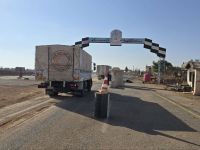Mining and milling of uranium ore: Uranium minerals are always associated with other elements such as radium and radon in radioactive decay series. Therefore, although uranium itself is barely radioactive, the ore which is mined must be regarded as potentially hazardous, especially if it is high-grade ore.
The radiation hazards involved however are virtually all due to the associated elements and are similar to those in many mineral sands operations.
Australian uranium mines have mostly been open cut and therefore naturally well ventilated. Ore grades at Ranger, as well as at the proposed Jabiluka and Kintyre mines, are less than 0.5 percent U3O8.
The Olympic Dam underground mine, with ore grade less than 0.1 percent U3O8. Any underground uranium mine is ventilated with powerful fans.
Canada's older mines at Cluff Lake, Key Lake and Rabbit Lake, as well as McClean Lake which started in 1999, are all open cut mines and well ventilated. The three newer mines now starting are underground operations.
Two of them, McArthur River and Cigar Lake, are in very high-grade ore and require special remote-control techniques for mining. There is some underground mining at Cluff Lake, and there will also be some at McClean Lake later.
The ore (i.e. rock containing economically recoverable concentrations of uranium) is crushed and ground. The resulting slurry is then leached, usually with sulfuric acid, to dissolve the uranium (together with some other metals).
The solids remaining after the uranium is extracted are pumped as a slurry to the tailings dam, which is engineered to retain them securely. Tailings contain most of the radioactive material in the ore, such as radium.
Two new Australian mines will be in situ leaching (ISL) operations, with recovery of the uranium from the sandy ore taking place underground.
A slightly acidic and heavily oxygenated solution is circulated through bores and the uranium is extracted in plant at the surface, with the liquor being recirculated.
In each case the leach liquor goes through a solvent extraction or ion exchange process followed by precipitation to remove the uranium from solution as a bright yellow precipitate ("yellowcake"). After high-temperature drying, the uranium oxide (U3O8), now khaki in colour, is packed into 200-litre drums for shipment.
The radiation dose rate one metre from such a drum of freshly processed U3O8 is about half that (from cosmic rays) received by a person on a commercial jet flight.
In Australia all these operations are undertaken under the Australian Code of Practice on Radiation Protection in the Mining and Milling of Radioactive Ores, administered by state governments.
In Canada, the Canadian Nuclear safety Commission regulations apply. In both countries they set strict health standards for gamma radiation and radon gas exposure* as well as for ingestion and inhalation of radioactive materials. Standards apply to both workers and members of the public.
* 20 mSv/yr averaged over 5 years is the maximum allowable radiation dose rate for workers, including radon (and radon daughters) dose. This is in addition to natural background and excludes medical exposure. See also Appendix 1 and glossary for definitions.
The gamma radiation comes principally from isotopes of bismuth and lead. The radon gas emanates from the rock (or tailings) as radium decays.* It then decays itself to (solid) radon daughters, which are energetic alpha-emitters.
Radon occurs in most rocks and traces of it are in the air we all breathe. However, at high concentrations it is a health hazard since its short half-life means that disintegrations giving off alpha particles are occurring relatively frequently. Alpha particles discharged in the lung can eventually give rise to lung cancer.
* "Radon" here normally refers to Rn-222. Another isotope, Rn-220 (known as "thoron"), is given off by thorium, which is a constituent of many Australian mineral sands. At Port Pirie in S.A. a rare earths treatment plant operating between 1968 and 1972 produced tailings containing thorium.
These gave rise to minor Rn-220 emissions in addition to Rn-222 emanating from earlier Radium Hill uranium tailings at the same site. See also Appendix 2.
A number of precautions are taken at a uranium mine to protect the health of workers:
Dust is controlled, so as to minimise inhalation of gamma or alpha-emitting minerals. In practice dust is the main source of radiation exposure in a uranium mine. At Ranger it typically contributes 4mSv/yr to a worker's annual dose.
Radiation exposure of workers in the mine, plant and tailings areas is limited. In practice direct radiation levels from the ore and tailings are usually so low that it would be difficult for a worker to come anywhere near the allowable annual dose.
Radon daughter exposure is limited in an open cut mine because there is sufficient natural ventilation. At Ranger the radon level seldom exceeds one percent of the levels allowable for continuous occupational exposure.
In an underground mine a good forced ventilation system is required to achieve the same result, - at Olympic Dam radiation doses are kept below 10 mSv/yr, with an average of about 3 mSv/yr. In Canada, doses average about 3 mSv/yr.
Strict hygiene standards are imposed on workers handling the uranium oxide concentrate. If it is ingested it has a chemical toxicity similar to that of lead oxide.* In effect, the same precautions are taken as in a lead smelter, with use of respiratory protection in particular areas identified by air monitoring.
*Both lead and uranium are toxic and affect the kidney. The body progressively eliminates most Pb or U, via the urine.
Since the fifteenth century many miners who had worked underground in the mountains near the present border between East Germany and the Czech Republic contracted a mysterious illness, and many died prematurely.
In the late 1800s the illness was diagnosed as lung cancer, but it was not until 1921 that radon gas was suggested as the possible cause.
Although this was confirmed by 1939, between 1946 and 1959 much underground uranium mining took place in the USA without the precautions which might have become established as a result of the European experience. In the early 1960s a higher than expected incidence of lung cancer began to show up among miners who smoked.
The cause was then recognized as the emission of alpha particles from radon and, more importantly, its solid daughter products of radioactive decay. The miners concerned had been exposed to high levels of radon 10-15 years earlier, accumulating radiation doses well in excess of present recommended levels.
The small unventilated uranium "gouging" operations in the USA which led to the greatest health risk are a thing of the past. In the last 35 years, individual mining operations have been larger, and efficient ventilation and other precautions now protect underground miners from these hazards.
Open cut mining of uranium virtually eliminates the danger. There has been no known case of illness caused by radiation among uranium miners in Australia or Canada.
While this may be partly due to the lack of detailed information on occupational health from operations in the 1950s, it is clear that no major occupational health effects have been experienced in either country.
After mining is complete most of the ore-body, with virtually all of the radioactive radium, thorium and actinium materials, will end up in the tailings dam.* Hence radiation levels and radon emissions from tailings will probably be significant.
In the unlikely event of someone setting up camp on top of the material, they could eventually receive a radiation dose exceeding international standards, just as they could from outcropping ore-bodies.
Therefore, the tailings need to be covered over with enough rock, clay and soil to reduce both gamma radiation levels and radon emanation rates to levels near those naturally occurring in the region. A vegetation cover can then be established.
About 95 percent of the radioactivity in the ore is from the U-238 decay series, totalling about 450 kBq/kg in ore with 0.3 percent U3O8 (eg from Ranger).
The U-238 series has 14 radioactive isotopes in secular equilibrium, thus each represents about 32 kBq/kg (irrespective of the mass proportion). When the ore is processed, the U-238 and the very much smaller masses of U-234 (and U-235) are removed.
The balance becomes tailings, and at this point has about 85 percent of its original intrinsic radioactivity. However, with the removal of most U-238, the following two short-lived decay products (Th-234 & Pa-234) soon disappear, leaving the tailings with a little over 70 percent of the radioactivity of the original ore after several months.
The controlling long lived isotope then becomes Th-230 which decays with a half life of 77,000 years to radium-226 followed by radon-222. (Alex Zapantis, Supervising Scientist Group, Australia).
Radon emanation from tailings during mining and before they are covered is sometimes seen as a general environmental hazard. However, traces of radon are emitted by minerals present in most rock and soil. Thus, apart from the local hazards mentioned above, the regional increase in radon release due to mining operations is very small.
Process water, which arises from settled tailings, contains radium and other metals that would be undesirable in the outside environment. This water is retained and evaporated so that the contained metals are retained in safe storage, as in an ore-body.
In fact process water is never released to natural waterways, but is stored in the tailings dam and (at Ranger) the original mine pit, and evaporated from there.
At Ranger, rainfall run-off is segregated in accordance with water quality, and high quality water from relatively undisturbed catchments is released during flood times*. Poorer quality water is retained on site and treated.
Originally this more contaminated water was to be released to the nearby creek during periods of high flow, but in practice none has ever been discharged.
* Radionuclide levels are not to exceed drinking water standards.
The former Australian uranium mine at Rum Jungle is best known to some people as a source of water pollution. Here the uranium ore was associated with a lot of sulphide mineralisation. In accordance with the low standards of the 1950s, few precautions were taken to prevent river pollution from the site either at the time or following mining**.
Large heaps of both waste rock and low-grade ore in the monsoon climate caused a large amount of acidic run-off, known as acid mine drainage.
**Metal sulphides in contact with water and air in a warm climate tend to react readily, particularly in the presence of certain bacteria. Sulphuric acid is generated and toxic heavy metals such as copper then go into solution and may be carried downstream.
The nuclear fuel cycle:
Fuel cycles describe the way in which fuel gets to nuclear reactors and what happens to it when it comes out. All aspects of obtaining and preparing the fuel, using it, and the management of spent fuel together make up what is known as the fuel cycle.
As the term suggests it has been the intention with nuclear power to recycle the unused part of the spent fuel so that it is incorporated into the fresh reactor fuel elements.
Unlike coal, uranium ore cannot be fed directly into a power station; it has to be purified, concentrated (usually) and made up into special fuel rods. Figure 10 shows the so-called "open fuel cycle" for nuclear power, which is the system as it stands today in most countries using the most common kinds of reactors.
Starting in uranium mines such as Olympic Dam or Ranger in Australia or the northern Saskatchewan mines of Canada, ore is mined and milled to produce uranium in the form of uranium oxide concentrate.
It is a mixture of two oxides, commonly known as U3O8. This material, a khaki-colored powder, is shipped to customers. It has the same isotopic ratio as the ore, where U-235 is present to the extent of about 0.7 percent.
The rest is a heavier isotope of uranium - U-238 (with traces of U-234). Most reactors, including the common light water type (LWR), cannot run on natural uranium, so the proportion of U-235 must be increased to about 3.5 percent. This is called enrichment. Canadian reactors use un-enriched uranium - see below.
Enrichment is a fairly high-technology physical process which requires the uranium to be in the form of a gas. The simplest way to achieve this is to convert the uranium oxide to uranium hexafluoride, which is a gas at little more than room temperature.
This form of uranium is commonly referred to as UF6 or "hex". Hence the first destination of uranium oxide concentrate from a mine is a conversion plant where it is purified and converted to uranium hexafluoride.
The UF6 is then fed to an enrichment plant* which increases the proportion of the fissile uranium-235 (U-235) isotope. In the process about 85 percent of the natural uranium feed is rejected as "depleted uranium" or "tails" (mainly U-238) which is stockpiled **. Thus, after enrichment about 15 percent of the original quantity is available as enriched uranium containing about 3.5 percent U-235.
*Most enrichment has so far been undertaken using the expensive and energy intensive gaseous diffusion process. Newer plants are mostly based on very much more efficient gas centrifuge technology. The next generation of enrichment plants may use advanced laser technology.
**This material cannot be used in current types of reactors, its only significant use is as a feed for fast breeder reactors, or to dilute ex-military uranium, see sections 4.4 & 3.5. It is stored as UF6 in steel cylinders. Usually less than 0.3 percent U-235 remains in it.
The enrichment methods now in use are based on the slight difference in atomic mass of U-235 and U-238. Much of the installed capacity relies on the gaseous diffusion process, where the UF6 gas is passed through a long series of membrane barriers which allow the lighter molecules with U-235 through faster than the U-238 ones.
More modern plants use high-speed centrifuges to separate the molecules of the two isotopes. Enriched uranium then goes on to a fuel fabrication plant where the reactor fuel elements are made. The UF6 is converted to uranium dioxide, a ceramic material, and formed into small cylindrical pellets about 2 cm long and 1.5cm in diameter. The pellets are loaded into zirconium alloy or stainless steel tubes about 4 meters long to form fuel rods.
These are assembled into bundles about 30 cm square to form reactor fuel assemblies. Fuel assemblies of this type are used to power the US-developed light water power reactor, currently the most popular design (see Table 5). A 1000 MWe reactor has about 75 tones of fuel in it.
Canadian CANDU (CANadian Deuterium Uranium) reactors have a different design, and run on natural (ie unenriched) uranium. Instead of a single large pressure vessel containing the core, they have multiple (eg 300-600) horizontal pressure tubes, each containing fuel and heavy water coolant. The pressure tubes extend through the reactor vessel, or calandria, which contains the heavy water moderator*. CANDU fuel bundles are only 10 cm in diameter and 50 cm long.
* Heavy water, or deuterium oxide, contains deuterium, which is an isotope of hydrogen having a neutron in the nucleus.
Inside all kinds of operating reactors a fission chain reaction occurs in the fuel rods, as described in 3.1. Fast neutrons are slowed by the water, heavy water or graphite moderator so that they can cause fission.
Neutron-absorbing control rods are inserted or withdrawn to regulate the speed of the reaction. Heat from the fission reaction is conveyed from the reactor core and is used to make steam, which in turn is used to generate electricity.
In a light water reactor the fuel stays in the reactor for about three years, generating heat from fission of both the U-235 and also the fissile plutonium (eg Pu-239) which is formed there.
After three years or so, the level of fission products and other neutron-absorbers has built up so that the reaction is slowing down, and the spent fuel assemblies are therefore removed. About one third of the fuel is changed each year. In a CANDU type, fuel stays in the reactor only 18 months or so.
When removed, spent fuel is hot and radioactive. It is therefore stored under water to remove the heat and to provide shielding from radiation, pending the next step.
This may be reprocessing in the case of countries such as UK, France and Japan, which have chosen to close the fuel cycle, or it may be final disposal in the case of countries such as USA, Canada and Sweden, which have chosen the "open fuel cycle".
Storage is initially at the reactor site. It may then be transferred elsewhere, or to an engineered dry storage facility.
Earlier generations of reactors, such as are still operating in the UK, use uranium metal fuel instead of uranium oxide, and are gas-cooled. For these reactors reprocessing operations have been going on for some time, so that the fuel elements are not held very long in cooling ponds.
This, and the corresponding arrangement for light water reactors, is illustrated by the more complex diagram in Figure 11 which is known as the "closed fuel cycle" system.
In the closed fuel cycle for light water reactors fuel is supplied in exactly the same way as before. Starting with uranium mines and mills the uranium goes through conversion, enrichment, and fuel fabrication to the reactor.
But when removed from the reactor the fuel rods are put through a reprocessing plant where they are chopped up and dissolved in acid.
Various chemical processes recover and separate the two valuable components: plutonium and unused uranium. This leaves about 3 percent of the fuel as high-level waste. After solidification it is reduced to a small volume of highly radioactive material suitable for permanent disposal.
About 96 percent of the uranium which goes into the reactors emerges again in the spent fuel, albeit depleted to less than 1 percent U-235. As shown in Figure 14 some of the remainder is converted into heat and radioactive fission products and some into plutonium and other actinide elements.
Hence reprocessing spent fuel has some economic benefits in recovering the unused uranium and the plutonium which has been generated and not burned in the reactor. It also substantially reduces the volume of material to be disposed of as high-level waste, which also has economic benefit.
Plutonium comprises about 1 percent of the spent fuel. It is a very good nuclear fuel which needs no enrichment process, it can be mixed with depleted uranium, made into fuel rods in a mixed oxide (MOX) fuel fabrication plant and put back into the reactor as fresh fuel . Alternatively it could be used to fuel future breeder reactors (see below).
The recovered uranium can go back to be enriched, and on into fresh fuel for a reactor. The closed fuel cycle is thus a more efficient system for making maximum use of the uranium dug out of the ground (by about 30 percent, in energy terms) and that is why the industry originally favoured this approach.
However, due largely to many years of low uranium prices (since about 1980), plans for widespread reprocessing of spent reactor fuel have not eventuated. France, Germany, UK, Russia and Japan are proceeding with the closed fuel cycle for oxide fuels, and across Europe over 35 reactors are licensed to load 20-50 percent of their core with MOX fuel containing up to 7 percent reactor-grade plutonium.
Source:U.I.C.EDU
© 2000 Mena Report (www.menareport.com)









